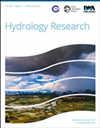Improvement of springtime streamflow prediction using a snow hydrology model aided with USDA SNOTEL and in-situ snowpit observations
IF 2.4
4区 环境科学与生态学
Q2 Environmental Science
引用次数: 0
Abstract
Estimating the streamflow driven by snowmelt in rugged mountain watersheds is difficult. Challenges are associated with the limited observations of hydrologic and meteorological datasets and inadequate implementation of the snow hydrology models. This study aims to improve streamflow prediction during the snowmelt season using a snow hydrology model aided by field observations. When the point-based weather forcing data and in-situ snowpit measurements exist in or near a small-scale (2–3 km2) watershed, the hydrologic model demonstrated an improved streamflow prediction during the snowmelt period. A snow hydrology model was applied to the Senator Beck Basin (SBB) in Colorado to improve the streamflow prediction. A temperature index method was implemented in the hydrological model to accommodate the snowmelt routine, which releases water as a multiplication factor for a grid temperature surplus above the melting point. The temperature index was adjusted using in-situ snowpit observations collected in the SBB by the NASA SnowEx Year-1 campaign in February 2017. Using the determined temperature index and weather forcing data from the nearby USDA snow observation telemetry station, the Nash-Sutcliffe Efficiency of the simulated streamflow was elucidated with a value of 0.88 against the observed streamflow during April 1–22, 2017.美国农业部SNOTEL和现场雪坑观测辅助下积雪水文模型对春季水流预报的改进
在崎岖的山地流域,估算融雪驱动的流量是很困难的。挑战与水文和气象数据集的有限观测以及积雪水文模型的不充分实施有关。本研究旨在利用野外观测辅助下的雪水文模型改进融雪季节的流量预测。当基于点的天气强迫数据和现场雪坑测量数据存在于小尺度(2 ~ 3 km2)流域内或附近时,该水文模型对融雪期的流量预测效果较好。将雪水文模型应用于科罗拉多州参议员贝克盆地(SBB),以改进径流预测。在水文模型中实现了温度指数方法,以适应融雪过程,将水作为熔点以上网格温度盈余的乘法因子释放。温度指数是根据2017年2月NASA SnowEx Year-1活动在SBB收集的现场雪坑观测数据进行调整的。利用美国农业部积雪观测遥测站确定的温度指数和天气强迫数据,对2017年4月1日至22日的实测流量进行了Nash-Sutcliffe效率模拟,其值为0.88。
本文章由计算机程序翻译,如有差异,请以英文原文为准。
求助全文
约1分钟内获得全文
求助全文
来源期刊

Hydrology Research
Environmental Science-Water Science and Technology
CiteScore
5.30
自引率
7.40%
发文量
70
审稿时长
17 weeks
期刊介绍:
Hydrology Research provides international coverage on all aspects of hydrology in its widest sense, and welcomes the submission of papers from across the subject. While emphasis is placed on studies of the hydrological cycle, the Journal also covers the physics and chemistry of water. Hydrology Research is intended to be a link between basic hydrological research and the practical application of scientific results within the broad field of water management.
 求助内容:
求助内容: 应助结果提醒方式:
应助结果提醒方式:


